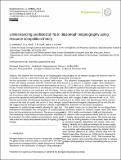Understanding predicted shifts in diazotroph biogeography using resource competition theory
Author(s)
Ward, B. A.; Dutkiewicz, Stephanie; Scott, Jeremy; Follows, Michael J
DownloadDutkiewicz-2014-Understanding predic.pdf (2.287Mb)
PUBLISHER_CC
Publisher with Creative Commons License
Creative Commons Attribution
Terms of use
Metadata
Show full item recordAbstract
We examine the sensitivity of the biogeography of nitrogen fixers to a warming climate and increased aeolian iron deposition in the context of a global earth system model. We employ concepts from the resource-ratio theory to provide a simplifying and transparent interpretation of the results. First we demonstrate that a set of clearly defined, easily diagnosed provinces are consistent with the theory. Using this framework we show that the regions most vulnerable to province shifts and changes in diazotroph biogeography are the equatorial and South Pacific, and central Atlantic. Warmer and dustier climates favor diazotrophs due to an increase in the ratio of supply rate of iron to fixed nitrogen. We suggest that the emergent provinces could be a standard diagnostic for global change models, allowing for rapid and transparent interpretation and comparison of model predictions and the underlying mechanisms. The analysis suggests that monitoring of real world province boundaries, indicated by transitions in surface nutrient concentrations, would provide a clear and easily interpreted indicator of ongoing global change.
Date issued
2014-10Department
Massachusetts Institute of Technology. Center for Global Change Science; Massachusetts Institute of Technology. Department of Earth, Atmospheric, and Planetary SciencesJournal
Biogeosciences
Publisher
Copernicus GmbH
Citation
Dutkiewicz, S., B. A. Ward, J. R. Scott, and M. J. Follows. “Understanding Predicted Shifts in Diazotroph Biogeography Using Resource Competition Theory.” Biogeosciences 11, no. 19 (2014): 5445–5461.
Version: Final published version
ISSN
1726-4189